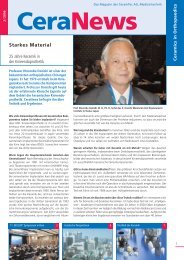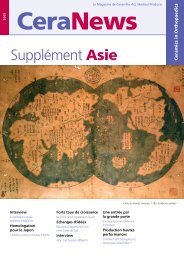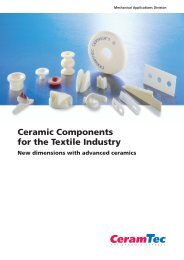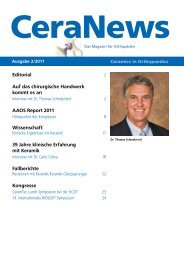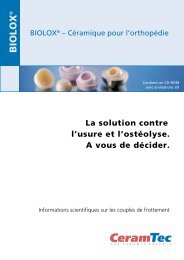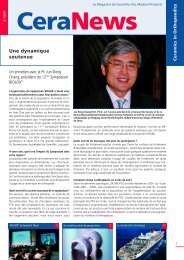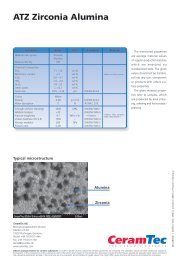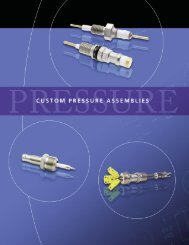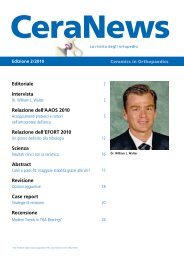Download PDF, 2.4 MB - CeramTec
Download PDF, 2.4 MB - CeramTec
Download PDF, 2.4 MB - CeramTec
You also want an ePaper? Increase the reach of your titles
YUMPU automatically turns print PDFs into web optimized ePapers that Google loves.
EFORT (continued)cular lymphocytic infiltration was significantly morepronounced than was the case with the CoP bearingcouples. There were more T cells detected thanB cells.Thus, there is a demonstrable correlation in patientswith MoM bearing couples (low carbon) betweenhypersensitivity reactions to metal wear and osteolysiswith resultant implant loosening.7-year results with CoP,MoP and MoM THAKristian Bjorgul (Norway) randomized 396cemented THA with CoP, MoP or MoM (high carbon)bearing couples and a 28mm femoral ballhead. An alumina ceramic femoral ball head wasused for the CoP bearing couple. A full PE acetabularcup was used for the MoP and the CoP THA.After 7 years, there had been 10 revisions, of which6 occurred in the MoM group (3 infections, 2 casesof aseptic loosening, 1 case of septic loosening), 3in the MoP group (infection, dislocation, pain) and1 in the CoP group (infection). Radiologic findingswere available for 335 hips. Periacetabular radiolucentlines measuring over 1mm were detected in19 of 110 MoM hips and 5 of 112 CoP hips, whilenone were detected at all in the MoP group. Onlyin the MoM group did 2 patients need to undergorevision surgery for acetabular cup loosening.Bjorgul concluded that the MoM group shouldtherefore be monitored closely for signs of asepticloosening.Clinical results with ceramics15-year results with CoC THAJames Buchanan (UK) reported on a series of 626CoC THA (28mm, with a total of 467 BIOLOX ® forteand 169 BIOLOX ® delta) with HA coated components,with more than 15 years of follow-up forthe BIOLOX ® forte implants. The patients underwentannual clinical and radiologic follow-ups.Aseptic loosening was only observed in 3 of theTHA (2 stems, 1 cup). Dislocation occurred in 6 ofthe THA due to malpositioning. Ceramic fracturesoccurred in 3 femoral ball heads and 2 inserts fromBIOLOX ® forte, but none occurred in BIOLOX ® deltaimplants. Neither osteolysis nor any form of particlerelateddisease were observed. At the time of thefinal follow-up 91% of the patients had an HHSof at least 90 points. Lower scores were primarilyattributable to other medical problems.It was hoped that ceramic implants would offer ahard-on-hard bearing couple with a high degree ofwear resistance without the metal-associated problemsof MoM bearing surfaces. The expectation wasconfirmed in this study, while the potential hazardof fractures was significantly reduced with the 4 thgeneration ceramics (BIOLOX ® delta).8.5-year results with CoC THAin patients < 60 yearsJérôme Essig (France) conducted a retrospectivestudy involving a consecutive series of 265 cementlessCoC THA (BIOLOX ® forte) with a mean followupof 8.5 (5–11) years. The average age of thepatients was 58 (22–78) years. 28mm femoral ballheads were used in 99% of the cases. Continuousclinical and radiological follow-up was possible in224 patients (232 hips).The survival rate with the endpoint of all revisionswas 96.6% after 10 years. Infections were identifiedin 4 cases, a periprosthetic femoral fracture in4 cases and dislocation in 1 case. Aseptic looseningand ceramic fractures were not observed. Nowear, osteolysis, or other particle-related diseasescould be detected. The mean HHS was 97.3 points.A noise phenomenon (squeaking) occurred in 16cases (6%) without there being any malpositioning.In 10 cases, the noise disappeared over time.Essig concluded that the wear-resistant CoC bearingcouple in this series proved itself effective in ayounger patient population.CeraNews 1/2012Ceramic-on-ceramic is a reliable selection of bearingsurfaces in patients of any age and either sex.- James Buchanan, MDThis series demonstrates that the implantationof an ana tomic cementless HAarthroplasty with an alumina bearing ina young and active patient prevents therisk of wear and osteo lysis and improvesdurability over time.- Jérôme Essig, MD16



